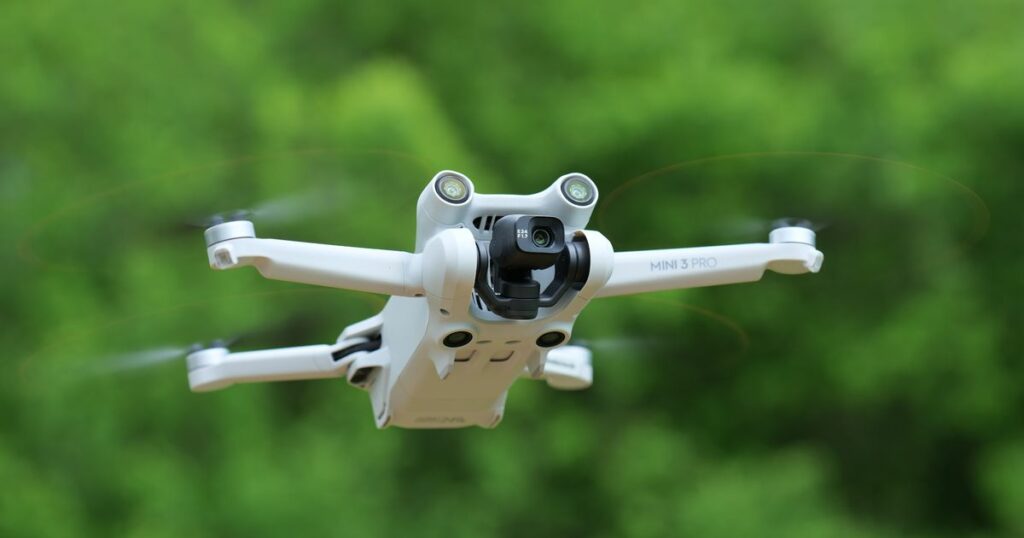For the Mini 3 Pro, DJI has completely reworked its imaging system. The optical unit of the Mini 3 Pro is mounted on a mechanical nacelle stabilized on three axes. It includes a 6.7 mm f/1.7 (24 mm eq.) lens based on a 1/1.3 inch CMOS sensor (2.4 μm pixel) with dual native ISO capable of take photos in 48 Mpx and film in 4K at 48/50 or 60 fps. The Mini 3 Pro also has an HDR video mode at 30 fps, as well as a 1080p slow motion mode at 120 fps. The DJI app allows you to work in a fully automated way or in pro mode with manual control over the shooting parameters, both in photos and in video.
In photos, you can therefore obtain shots in jpeg/raw (DNG) in the highest definition (48 Mpx) at the ratio 4/3, i.e. 8064 x 6048 px. In video, you can film in the following formats with a maximum bit rate of 150 Mb/s (H.265):
- 4K: 3840 x 2160 px at 24/25/30/48/50/60 fps
- 2.7K: 2720 x 1530 px at 24/25/30/48/50/60 fps
- FHD: 1920 x 1080 px at 24/25/30/48/50/60 fps
- Slow Motion: 1920 x 1080 px at 120 fps
The ISO sensitivity in photo or video ranges from 100 to 6400.
Watching our test videos demonstrates the very good image quality produced by the Mini 3 Pro. The stabilization is remarkable, the images very fluid and the colorimetry flattering (sometimes a little too much…). The Mini 3 Pro also offers a D-cinelike mode giving much more latitude in correction for post-production specialists.
Shot taken in Automatic mode. 24mm f/1.7, 1/1500 sec lens. © Romane Riesse – Digital
The small sensor of the Mini 3 Pro is not that of the Mavic 3 and shows its weaknesses in the management of chroma noise in the dark parts of the image, a phenomenon also observed on some of our photos by zooming very strongly on the parts dark. A thorough examination of the images produced in the laboratory should allow us to see more clearly. Finally, we advise you to avoid zoom functions, which are only digital zooms with loss of image quality. Favor camera movements in film mode, which are fluid and much more interesting qualitatively speaking.
Studio / electronic noise management (pictured)
In photos, the small sensor of the Mini 3 Pro does not work miracles, but the service remains very honest with a start of smoothing from 400 ISO. Smoothing is more destructive at 800 ISO while remaining acceptable, but if possible avoid exceeding 1600 ISO to keep a little detail in the images. In raw, it will be possible to retain a little more nuance and precision in the shots, with however much more visible digital noise.


Studio / Image Accuracy (Photo)
The sensor/optics couple of the DJI Mini 3 Pro delivers well detailed shots and the Chinese brand knows how to exploit the high definition of the sensor. On the examples below, you can see that the Mini 3 Pro is much more precise than the Xiaomi Redmi 9T smartphone, for example, which is also equipped with a 48 Mpx sensor.


We also wanted to compare the newcomer with the DJI Air 2S which offers a 20 Mpx sensor.


We also resized an image of the Mini 3 Pro to 20MP for easier comparison. In auto mode, the images are finally quite close with an advantage in precision for the Mini 3 Pro which benefits from an increase in pixels for sampling. The Mini 3 Pro therefore retains good photo quality while providing an always appreciable additional definition.


Studio / Image Accuracy (Video)
In video mode with 4K recording, the differences between Air 2S and Mini 3 Pro fade. The precision of the images is similar, despite a different compression (H.265 for the Mini 3 Pro and H.264 for the Air 2S). We just note a slightly more marked accentuation on the Air 2S which makes the image a little more flattering. In the studio, therefore, the Mini 3 Pro fulfills the specifications with flying colors.



